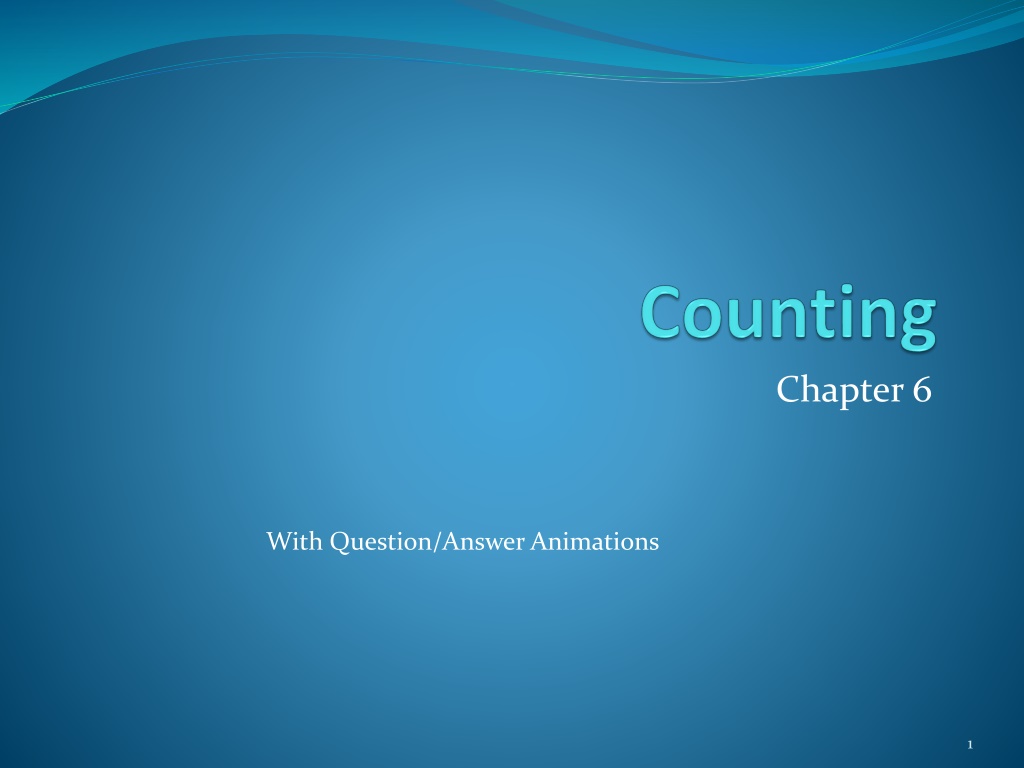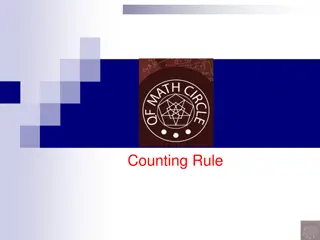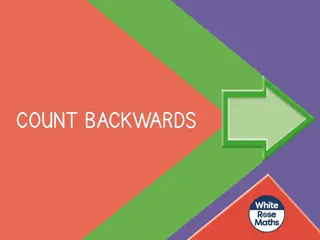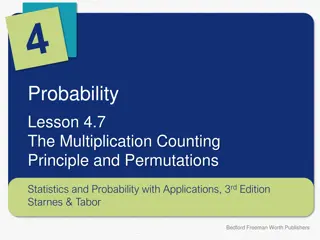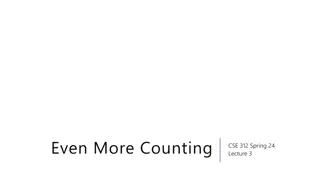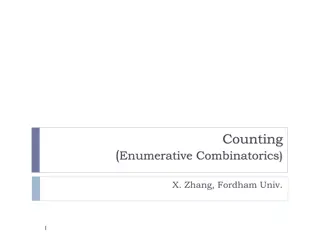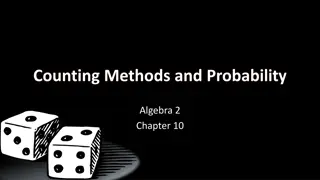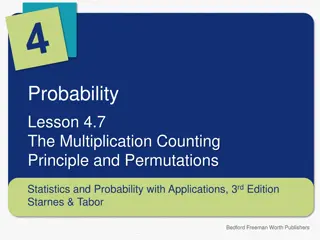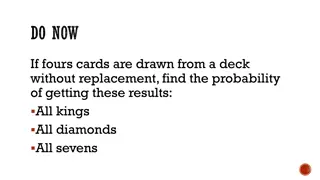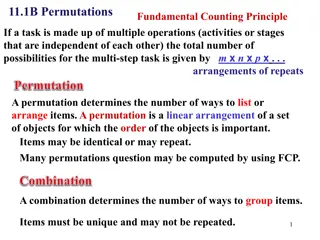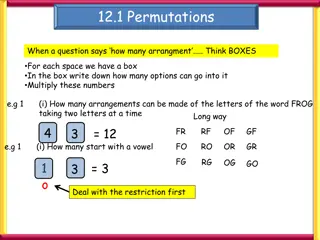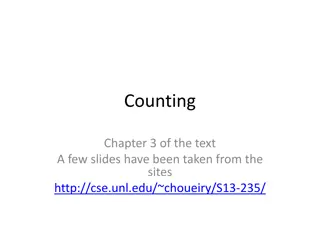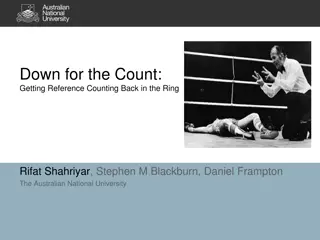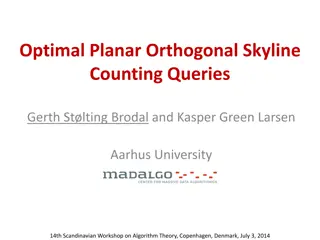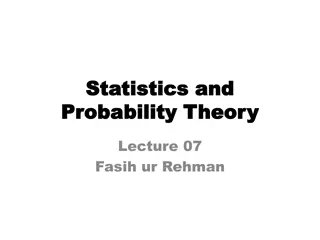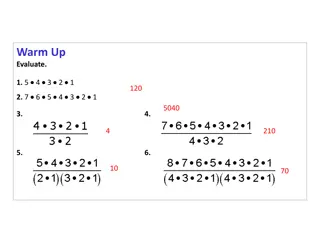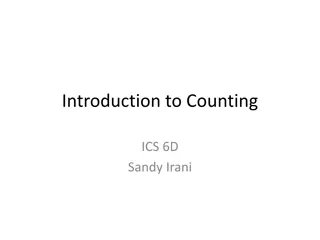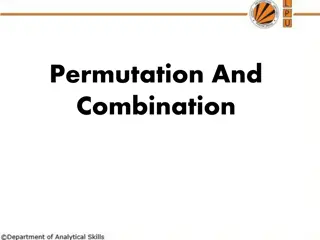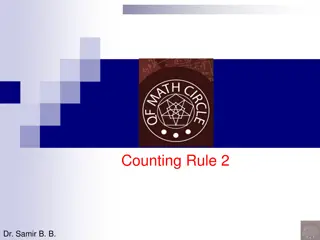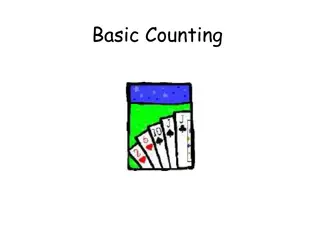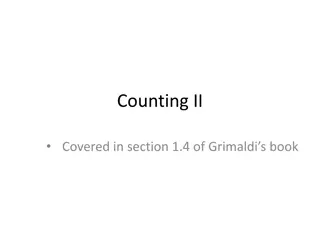Counting Principles and Permutations
This content provides an overview of counting principles, permutations, and formulae for calculating permutations. Examples and solutions are included to illustrate the application of these concepts in solving counting problems.
Download Presentation

Please find below an Image/Link to download the presentation.
The content on the website is provided AS IS for your information and personal use only. It may not be sold, licensed, or shared on other websites without obtaining consent from the author.If you encounter any issues during the download, it is possible that the publisher has removed the file from their server.
You are allowed to download the files provided on this website for personal or commercial use, subject to the condition that they are used lawfully. All files are the property of their respective owners.
The content on the website is provided AS IS for your information and personal use only. It may not be sold, licensed, or shared on other websites without obtaining consent from the author.
E N D
Presentation Transcript
Chapter 6 With Question/Answer Animations 1
Chapter Summary The Basics of Counting The Pigeonhole Principle Permutations and Combinations Binomial Coefficients and Identities Generalized Permutations and Combinations Generating Permutations and Combinations (not yet included in overheads) 2
Section Summary Permutations Combinations Combinatorial Proofs 4
Permutations Definition: A permutation of a set of distinct objects is an ordered arrangement of these objects. An ordered arrangement of r elements of a set is called an r-permuation. Example: Let S = {1,2,3}. The ordered arrangement 3,1,2 is a permutation of S. The ordered arrangement 3,2 is a 2-permutation of S. The number of r-permutations of a set with n elements is denoted by P(n,r). The 2-permutations of S = {1,2,3} are 1,2; 1,3; 2,1; 2,3; 3,1; and 3,2. Hence, P(3,2) = 6. 5
A Formula for the Number of Permutations Theorem 1 1: If n is a positive integer and r is an integer with 1 r n, then there are P(n, r) = n(n 1)(n 2) (n r + 1) r-permutations of a set with n distinct elements. Proof: Use the product rule. The first element can be chosen in n ways. The second in n 1 ways, and so on until there are (n ( r 1)) ways to choose the last element. Note that P(n,0) = 1, since there is only one way to order zero elements. Corollary 1 1: If n and r are integers with 1 r n, then 6
Solving Counting Problems by Counting Permutations Example: How many ways are there to select a first- prize winner, a second prize winner, and a third-prize winner from 100 different people who have entered a contest? Solution: P(100,3) = 100 99 98 = 970,200 7
Solving Counting Problems by Counting Permutations (continued) Example: Suppose that a saleswoman has to visit eight different cities. She must begin her trip in a specified city, but she can visit the other seven cities in any order she wishes. How many possible orders can the saleswoman use when visiting these cities? Solution: The first city is chosen, and the rest are ordered arbitrarily. Hence the orders are: 7! = 7 6 5 4 3 2 1 = 5040 If she wants to find the tour with the shortest path that visits all the cities, she must consider 5040 paths! 8
Solving Counting Problems by Counting Permutations (continued) Example: How many permutations of the letters ABCDEFGH contain the string ABC ? Solution: We solve this problem by counting the permutations of six objects, ABC, D, E, F, G, and H. 6! = 6 5 4 3 2 1 = 720 9
Combinations Definition: An r-combination of elements of a set is an unordered selection of r elements from the set. Thus, an r-combination is simply a subset of the set with r elements. The number of r-combinations of a set with n distinct elements is denoted by C(n, r). The notation is also used and is called a binomial coefficient. (We will see the notation again in the binomial theorem in Section6.4.) Example: Let S be the set {a, b, c, d}. Then {a, c, d} is a 3- combination from S. It is the same as {d, c, a} since the order listed does not matter. C(4,2) = 6 because the 2-combinations of {a, b, c, d} are the six subsets {a, b}, {a, c}, {a, d}, {b, c}, {b, d}, and {c, d}. 10
Combinations Theorem 2 2: The number of r-combinations of a set with n elements, where n r 0, equals Proof Proof: By the product rule P(n, r) = C(n,r) P(r,r). Therefore, 11
Combinations Example: How many poker hands of five cards can be dealt from a standard deck of 52 cards? Also, how many ways are there to select 47 cards from a deck of 52 cards? Solution: Since the order in which the cards are dealt does not matter, the number of five card hands is: The different ways to select 47 cards from 52 is This is a special case of a general result. 12
Combinations Corollary 2 2: Let n and r be nonnegative integers with r n. Then C(n, r) = C(n, n r). Proof Proof: From Theorem 2, it follows that and Hence, C(n, r) = C(n, n r). This result can be proved without using algebraic manipulation. 13
Combinatorial Proofs Definition 1 1: A combinatorial proof of an identity is a proof that uses one of the following methods. A double counting proof uses counting arguments to prove that both sides of an identity count the same objects, but in different ways. A bijective proof shows that there is a bijection between the sets of objects counted by the two sides of the identity. 14
Combinatorial Proofs Here are two combinatorial proofs that C(n, r) = C(n, n r) when r and n are nonnegative integers with r < n: Bijective Proof: Suppose that S is a set with n elements. The function that maps a subset A of S to is a bijection between the subsets of S with r elements and the subsets with n r elements. Since there is a bijection between the two sets, they must have the same number of elements. Double Counting Proof: By definition the number of subsets of S with r elements is C(n, r). Each subset A of S can also be described by specifying which elements are not in A, i.e., those which are in . Since the complement of a subset of S with r elements has n r elements, there are also C(n, n r) subsets of S with r elements. 15
Combinations Example: How many ways are there to select five players from a 10-member tennis team to make a trip to a match at another school. Solution: By Theorem 2, the number of combinations is Example: A group of 30 people have been trained as astronauts to go on the first mission to Mars. How many ways are there to select a crew of six people to go on this mission? Solution: By Theorem 2, the number of possible crews is 16
Section 6.4 17
Section Summary The Binomial Theorem Pascal s Identity and Triangle Other Identities Involving Binomial Coefficients (not currently included in overheads) 18
Binomial Theorem Binomial Theorem: Let x and y be variables, and n a nonnegative integer. Then: Proof: We use combinatorial reasoning . The terms in the expansion of (x + y)n are of the form xn jyjfor j = 0,1,2, ,n. To form the term xn jyj, it is necessary to choose n jx s from the n sums. Therefore, the coefficient of xn jyj is which equals . 19
Using the Binomial Theorem Example: What is the coefficient of x12y13 in the expansion of (2x 3y)25? Solution: We view the expression as (2x +( 3y))25. By the binomial theorem Consequently, the coefficient of x12y13 in the expansion is obtained when j = 13. 20
Blaise Pascal (1623-1662) Pascal s Identity Pascal s Identity: If n and k are integers with n k 0, then Proof (combinatorial): Let T be a set where |T| = n + 1,a T, and S = T {a}. There are subsets of T containing k elements. Each of these subsets either: contains a with k 1 other elements, or contains k elements of S and not a. There are subsets of k elements that contain a, since there are subsets of k 1 elements of S, subsets of k elements of T that do not contain a, because there are subsets of k elements of S. Hence, See Exercise 19 for an algebraic proof. 21
Pascals Triangle The nth row in the triangle consists of the binomial coefficients , k = 0,1, .,n. By Pascal s identity, adding two adjacent bionomial coefficients results is the binomial coefficient in the next row between these two coefficients. 22
Section 6.5 23
Section Summary Permutations with Repetition Combinations with Repetition Permutations with Indistinguishable Objects Distributing Objects into Boxes 24
Permutations with Repetition Theorem 1 1: The number of r-permutations of a set of n objects with repetition allowed is nr. Proof: There are n ways to select an element of the set for each of the r positions in the r-permutation when repetition is allowed. Hence, by the product rule there are nrr-permutations with repetition. Example: How many strings of length r can be formed from the uppercase letters of the English alphabet? Solution: The number of such strings is 26r, which is the number of r-permutations of a set with 26 elements. 25
Combinations with Repetition Example: How many ways are there to select five bills from a box containing at least five of each of the following denominations: $1, $2, $5, $10, $20, $50, and $100? Solution: Place the selected bills in the appropriate position of a cash box illustrated below: continued 26
Combinations with Repetition Some possible ways of placing the five bills: The number of ways to select five bills corresponds to the number of ways to arrange six bars and five stars in a row. This is the number of unordered selections of 5 objects from a set of 11. Hence, there are ways to choose five bills with seven types of bills. 27
Combinations with Repetition Theorem 2: The number 0f r-combinations from a set with n elements when repetition of elements is allowed is C(n + r 1,r) = C(n + r 1, n 1). Proof: Each r-combination of a set with n elements with repetition allowed can be represented by a list of n 1 bars and r stars. The bars mark the n cells containing a star for each time the ith element of the set occurs in the combination. The number of such lists is C(n + r 1, r), because each list is a choice of the r positions to place the stars, from the total of n + r 1positions to place the stars and the bars. This is also equal to C(n + r 1, n 1), which is the number of ways to place the n 1 bars. 28
Combinations with Repetition Example: Suppose that a cookie shop has four different kinds of cookies. How many different ways can six cookies be chosen? Solution: The number of ways to choose six cookies is the number of 6-combinations of a set with four elements. By Theorem 2 is the number of ways to choose six cookies from the four kinds. 29
Summarizing the Formulas for Counting Permutations and Combinations with and without Repetition 30
